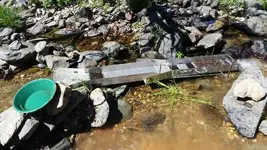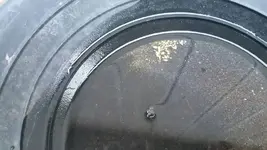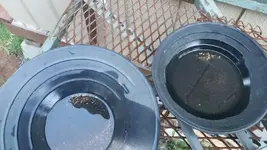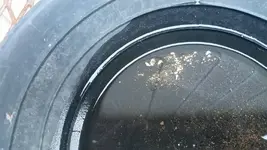SRP_KBell
Full Member
- #1
Thread Owner
This thread was created to educate forum members on the past, present and future of fluidized sluices. It is not intended to create anger or frustration but rather present information and foster discussion. The goal is to help members who may be interested in purchasing and using this technology.
In the early nineties, Howard Schmidt patented and sold the Schmidt Gold Trap Dredge (nicknamed the Bazooka) which used a unique dual venturi design to draw water into a trap through tubes with holes directed into the trap. The main objective was to fluidize the trap to create a material exchange to exhaust waste material and keep the heavy material while handling the high levels of throughput volume that a dredge nozzle creates. This system was marginally effective and very angle dependant.
Schmidt later attempted to create a similar process using only stream flow in a sluice called the Black Magic by adapting a shortened and modified trap design. This sluice retained the high levels of throughput but failed in achieving the fluidization, exchange and exhaust process of even the original dredge design. The main culprit for failure was not having any water pressure to drive the spray tubes that caused fluidization in the trap. Water pressure at the atmospheric line, (where water touches air) is zero. Having a box three or four inches under water also does not affect pressure to any degree. Also once the trap has material covering the holes of the spray tubes, the weight of this material creates additional resistance. At best, there will only be a very small amount of water entering the trap tubes, primarily due to following the path of least resistance.
One additional point needs to be clarified – Neither of Schmidt’s models created efficient (high percentage) gold recovery in a fluidized system. Throughput with no material classification was always the primary objective.
In 2003, work began to update the “fluid bed” concept in a stream sluice format. A full-length conical shape was adopted instead of the straight design of the Schmidt, and the trap was moved to the rear of the sluice instead of the center in the original configuration. The basic Black Magic tube system for fluidization was retained, and the water scoop lengthened. This combination of sluice shape and length of scoop made the tube fluidizing system susceptible to clogging and more difficult to clear once clogged.
This sluice retains the high throughput capabilities of the original designs but creates additional problems. Its conical shape increases water velocity in the trap which in turn increases material throughput speed and shortens the time for heavy materials to separate and fall into the trap. Another drawback in the design is that the trap operates at full material capacity like the original - Once full, the primary force is directed straight through the sluice and material entering the trap has no space to be processed. Also since there is no action on the incoming material to help facilitate separation and extraction, it exits the sluice without being fully processed. This newer design also retains the same tube fluidization method with the same issues of the original designs. These issues will plague any current or future products that use this design.
Fluid Dynamic sluices are the latest evolution in fluid sluices. They combine high rates of throughput but add opposing water forces entering on each side of the trap to slow the primary water flow and process the incoming material, facilitating separation and extraction and creating space for incoming material. There is also a mid trap partition that enhances extraction by further slowing material. Oscillation is also created as water passes through the sluice providing the necessary motion to facilitate the complete exchange of material in the trap. Another key feature is the flip-up material tray cover that allows you to visually inspect the trap or easily clean the sluice into a pan. Fluid Dynamic sluices also incorporate a “pass-through” water system that eliminates clogging issues that plague fluid bed systems.
The material throughput of the new sluice approach is about 85% of the current fluid bed design when comparing their relative sizes. However, there is a significant increase in the percentage of pay gold recovery which negates any material volume decrease. One last bonus of the Fluid Dynamic Sluice Design is that it is considerably lighter in weight and more compact in size making it much easier to carry. This allows prospectors and miners to travel more quickly and safely to their mining locations or provide the ability to test distant locations. With these advancements, true progress is moving forward.
In the early nineties, Howard Schmidt patented and sold the Schmidt Gold Trap Dredge (nicknamed the Bazooka) which used a unique dual venturi design to draw water into a trap through tubes with holes directed into the trap. The main objective was to fluidize the trap to create a material exchange to exhaust waste material and keep the heavy material while handling the high levels of throughput volume that a dredge nozzle creates. This system was marginally effective and very angle dependant.
Schmidt later attempted to create a similar process using only stream flow in a sluice called the Black Magic by adapting a shortened and modified trap design. This sluice retained the high levels of throughput but failed in achieving the fluidization, exchange and exhaust process of even the original dredge design. The main culprit for failure was not having any water pressure to drive the spray tubes that caused fluidization in the trap. Water pressure at the atmospheric line, (where water touches air) is zero. Having a box three or four inches under water also does not affect pressure to any degree. Also once the trap has material covering the holes of the spray tubes, the weight of this material creates additional resistance. At best, there will only be a very small amount of water entering the trap tubes, primarily due to following the path of least resistance.
One additional point needs to be clarified – Neither of Schmidt’s models created efficient (high percentage) gold recovery in a fluidized system. Throughput with no material classification was always the primary objective.
In 2003, work began to update the “fluid bed” concept in a stream sluice format. A full-length conical shape was adopted instead of the straight design of the Schmidt, and the trap was moved to the rear of the sluice instead of the center in the original configuration. The basic Black Magic tube system for fluidization was retained, and the water scoop lengthened. This combination of sluice shape and length of scoop made the tube fluidizing system susceptible to clogging and more difficult to clear once clogged.
This sluice retains the high throughput capabilities of the original designs but creates additional problems. Its conical shape increases water velocity in the trap which in turn increases material throughput speed and shortens the time for heavy materials to separate and fall into the trap. Another drawback in the design is that the trap operates at full material capacity like the original - Once full, the primary force is directed straight through the sluice and material entering the trap has no space to be processed. Also since there is no action on the incoming material to help facilitate separation and extraction, it exits the sluice without being fully processed. This newer design also retains the same tube fluidization method with the same issues of the original designs. These issues will plague any current or future products that use this design.
Fluid Dynamic sluices are the latest evolution in fluid sluices. They combine high rates of throughput but add opposing water forces entering on each side of the trap to slow the primary water flow and process the incoming material, facilitating separation and extraction and creating space for incoming material. There is also a mid trap partition that enhances extraction by further slowing material. Oscillation is also created as water passes through the sluice providing the necessary motion to facilitate the complete exchange of material in the trap. Another key feature is the flip-up material tray cover that allows you to visually inspect the trap or easily clean the sluice into a pan. Fluid Dynamic sluices also incorporate a “pass-through” water system that eliminates clogging issues that plague fluid bed systems.
The material throughput of the new sluice approach is about 85% of the current fluid bed design when comparing their relative sizes. However, there is a significant increase in the percentage of pay gold recovery which negates any material volume decrease. One last bonus of the Fluid Dynamic Sluice Design is that it is considerably lighter in weight and more compact in size making it much easier to carry. This allows prospectors and miners to travel more quickly and safely to their mining locations or provide the ability to test distant locations. With these advancements, true progress is moving forward.









